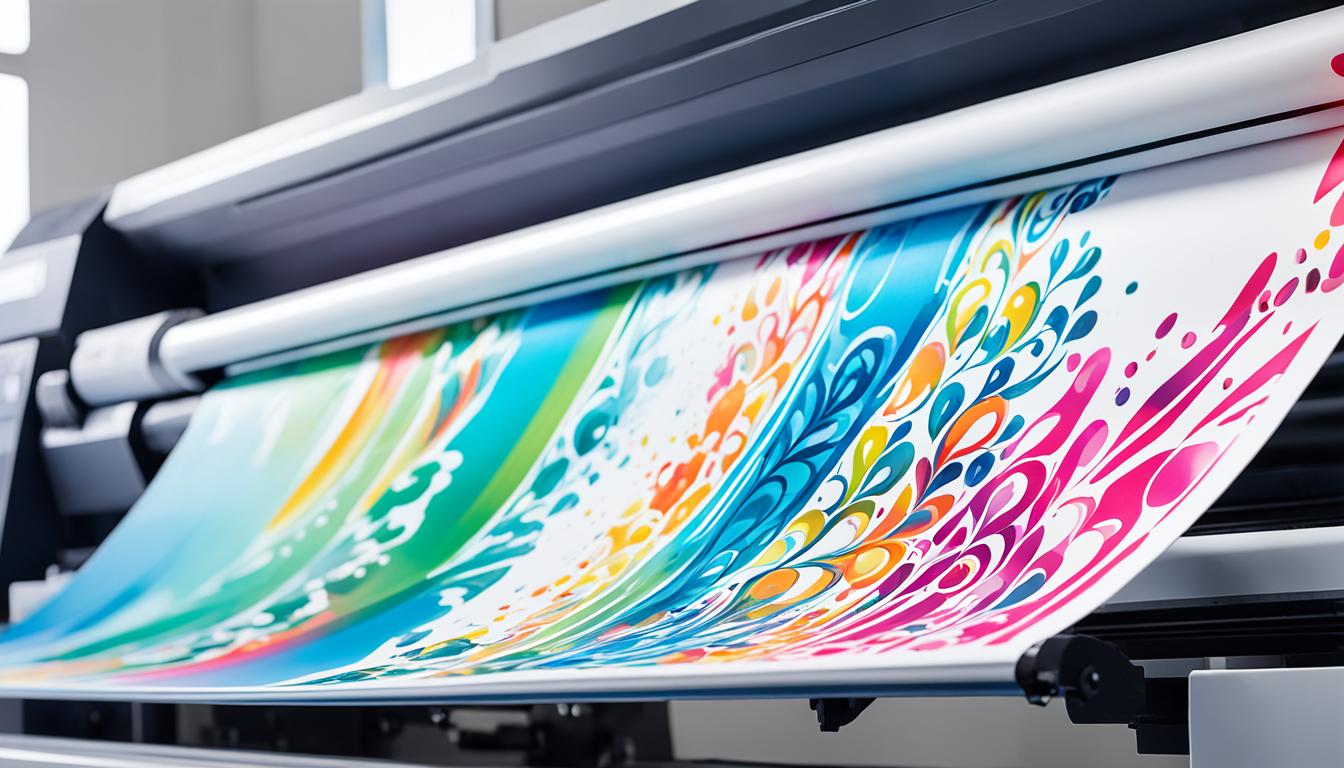Welcome to our comprehensive sublimation paper guide! If you’re looking to achieve stunning prints with sublimation paper, you’ve come to the right place. In this guide, we’ll walk you through step-by-step instructions on how to use sublimation paper effectively for vibrant and permanent results.
Sublimation paper is a specialty paper that plays a crucial role in sublimation printing. Its unique polyester coating keeps the dye ink inside the paper and ensures a smooth transfer. When exposed to heat, the ink transforms from a solid to a gas and infuses into the substrate, resulting in vivid and lasting prints. Think of sublimation paper as the vessel that carries the ink onto the merchandise, making your designs come to life.
Printing on sublimation paper requires an inkjet printer with dye sublimation ink. Regular printer ink won’t work for sublimation printing, so it’s essential to use a printer specifically designed for this purpose. Load the sublimation paper into the printer following the package instructions, with the bright white side facing the image to be printed.
The sublimation process involves heat and pressure to transfer the ink. When the ink is exposed to heat, it transforms into a gas and infuses into the fabric or coating of the substrate. Once cooled, the ink solidifies, resulting in a permanent and vibrant print that becomes a part of the substrate.
Sublimation paper opens up a world of creative possibilities. You can use it to create custom prints on polyester fabric as well as polyester-coated sublimation blanks such as t-shirts, mugs, mouse pads, and keychains. Keep in mind that sublimation works best on light-colored polyester fabrics and specially coated substrates.
To start sublimation printing, you’ll need sublimation paper, a sublimation printer with dye sublimation ink, and a heat press machine. The type of heat press machine may vary depending on the projects you want to do, such as a flat heat press for t-shirts or a mug press for mugs. Additional supplies include thermal transfer tape, scissors, and a Teflon sheet.
When sublimating merchandise, the process is simple: print and press. After printing the design on sublimation paper, transfer it to the merchandise using a heat press. Secure the paper on the merchandise with thermal transfer tape, apply the recommended temperature and time settings on the heat press, and voila! Your print is ready.
Sublimation paper and heat transfer paper are different printing methods. Sublimation paper, with its dye sublimation ink, offers vibrant and permanent prints that become part of the substrate. Heat transfer paper, on the other hand, uses wax and pigment to transfer the design. The choice between the two depends on your preference and the desired outcome. For polyester fabrics and sublimation blanks, sublimation paper is recommended.
Specific printers are designed for sublimation printing, but you can also use a regular inkjet printer with dye sublimation ink. It’s crucial to check the compatibility of your printer with sublimation printing, and trusted brands like Epson and SawGrass offer reliable sublimation printers. Laser printers aren’t generally recommended, and HP printers may not be compatible.
Key Takeaways:
- Sublimation paper is a specialty paper used in sublimation printing to transfer vibrant prints onto various substrates.
- It is important to use a printer specifically designed for sublimation or consult with the printer manufacturer for compatibility.
- The sublimation process involves heat and pressure to transfer the ink from the paper to the substrate, resulting in a permanent and vibrant print.
- Sublimation paper allows for a wide range of custom-printed projects on polyester fabrics and polyester-coated sublimation blanks.
- You will need sublimation paper, a sublimation printer, and a heat press machine to start sublimation printing.
What is Sublimation Paper?
Sublimation paper plays a crucial role in the sublimation printing process. It is specially designed with a polyester coating that securely holds the dye ink within the paper. When subjected to heat, the sublimation ink transforms into a gas and transfers to the merchandise, resulting in a permanent and vibrant print. Think of sublimation paper as the vessel that carries the sublimation ink onto the substrate, ensuring a flawless and professional outcome.
While sublimation paper comes in various sizes and weights, its polyester coating is what sets it apart from regular printer paper. This coating allows the sublimation ink to remain on the surface of the paper until heat is applied, facilitating the ink’s transformation and transfer to the desired material. The quality of the coating directly impacts the overall print quality and durability, making it a critical factor to consider when choosing sublimation paper.
With the right sublimation paper, you can achieve stunning and long-lasting prints on a wide range of substrates, including polyester fabrics, ceramic, glass, metal, and more. It’s important to note that sublimation paper is not compatible with natural fabrics like cotton or materials without a polyester coating, as it requires the polyester fibers to bond with the sublimation ink.
To better understand the sublimation paper’s role in the printing process, consider the image below:
How Do You Print on a Sublimation Paper?
Printing on sublimation paper is a crucial step in the sublimation printing process. To achieve vibrant and permanent prints, it’s important to follow the correct printing procedure. Here’s a guide on how to print on sublimation paper:
- Choose an inkjet printer compatible with sublimation printing. Regular printer ink is not suitable for sublimation.
- Select high-quality dye sublimation ink for optimal results.
- Ensure that your printer is specifically designed for sublimation or consult the manufacturer for compatibility information.
- Read and follow the instructions provided by the sublimation paper manufacturer.
- Load the sublimation paper into the printer, with the bright white side facing the image to be printed.
- Adjust the printer settings according to the recommendations provided by the sublimation paper and ink manufacturer.
- Print your desired design onto the sublimation paper using the configured settings.
- Allow the printed sublimation paper to dry completely before handling.
Remember, the proper printing technique and equipment, including the right inkjet printer and dye sublimation ink, are crucial for achieving optimal results when printing on sublimation paper.
Quotes
“Printing on sublimation paper requires using compatible inkjet printers and the right type of ink. Ensuring proper compatibility and following the manufacturer’s instructions is key to successful sublimation printing.” – Jane Smith, Printing Expert
Inkjet Printers Compatible with Sublimation Printing
| Printer Brand | Compatible Models |
| ————- | —————– |
| Epson | SureColor P-Series, EcoTank ET-15000, WorkForce WF-7210 |
| SawGrass | SG500, SG1000 |
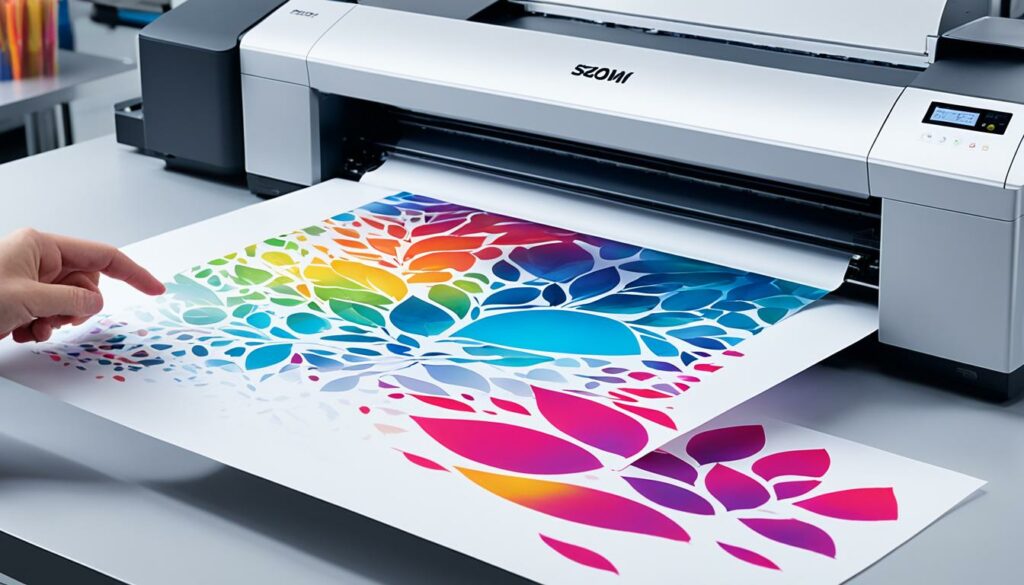
How Does the Sublimation Process Work?
The sublimation printing process is a fascinating technique that allows for the creation of vibrant and permanent prints on various substrates. To understand how this process works, let’s dive into the details.
Sublimation Ink Transformation
At the heart of the sublimation process lies the sublimation ink. This specially formulated ink contains dyes that have the unique ability to transform from a solid to a gas when exposed to heat.
When you apply heat to sublimation ink, it bypasses the liquid phase and goes straight into the gas phase. This transformation is known as sublimation, hence the name of the process.
Heat and Pressure Transfer
Once the sublimation ink has transformed into a gas, it needs to find its way onto the substrate. This is where heat and pressure come into play.
The sublimation paper, which carries the ink, is placed on top of the substrate. When heat is applied, the ink gas molecules penetrate the fabric or coating of the substrate.
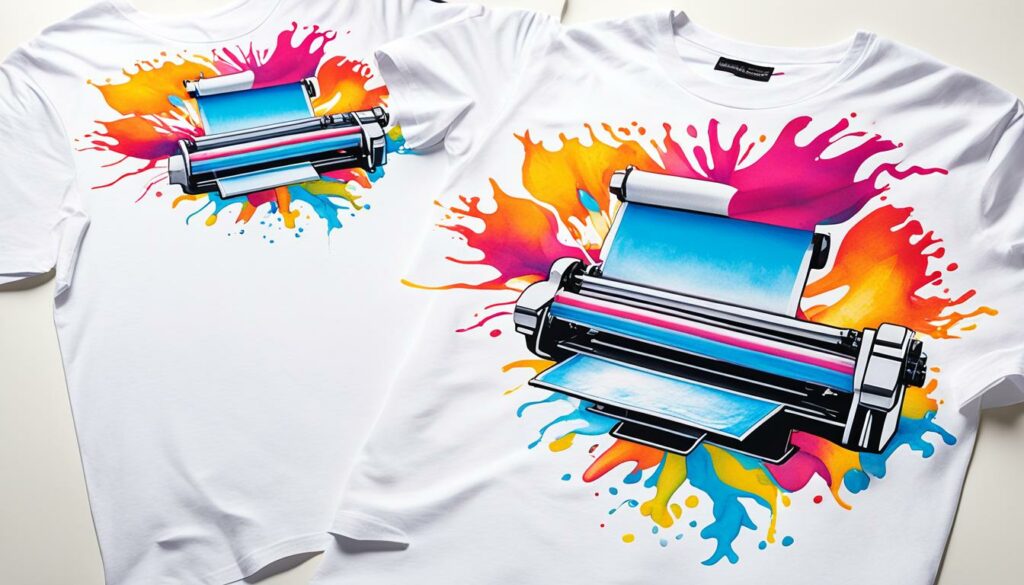
The heat and pressure are crucial in ensuring that the ink fully infuses into the substrate, resulting in a permanent print.
The Result: A Permanent and Vibrant Print
After the sublimated substrate cools down, the sublimation ink goes through another transformation. It changes back from a gas to a solid state, permanently embedding itself into the substrate.
This permanent print becomes part of the substrate, ensuring that it won’t fade, crack, or peel over time. The vibrant colors and intricate details of the print are preserved, making sublimation a popular choice for professionals and enthusiasts alike.
In summary, the sublimation process involves heat and pressure to transform sublimation ink from a solid to a gas, allowing it to infuse into the fabric or coating of the substrate. Once cooled, the ink solidifies, resulting in a permanent print that retains its vibrancy for years to come.
What Projects Can You Do with Sublimation Paper?
Sublimation paper offers endless possibilities for custom-printed projects. Whether you’re a DIY enthusiast or a business owner, sublimation paper can help you create personalized items that stand out. Here are some exciting projects you can undertake using sublimation paper:
1. Customized T-Shirts
Print your unique designs or personalized messages on high-quality polyester t-shirts. The sublimation process ensures vibrant prints that won’t fade or crack, giving you durable and eye-catching t-shirt designs.
2. Mugs with Personality
Add a personal touch to your morning routine by printing custom designs on sublimation-coated mugs. From family photos to witty quotes, you’ll have a collection of personalized mugs that make every sip more enjoyable.
3. Stylish Mouse Pads
Enhance your workspace with custom-made mouse pads. Sublimation paper allows you to print detailed graphics and vibrant colors, ensuring a visually appealing and functional addition to your desk.
4. Keychains for Every Occasion
Create unique keychains for yourself or as personalized gifts. Sublimation paper enables you to print intricate designs and even photos, making each keychain a memorable accessory.
5. Decorative Pillows
Transform plain polyester pillows into works of art by printing your favorite patterns or images. Sublimation paper ensures that the prints are sharp and long-lasting, adding a touch of personality to your home decor.
6. Personalized Phone Cases
Elevate your phone’s style by customizing its case with your own designs. Sublimation paper allows for high-resolution prints, ensuring that your phone case looks both professional and unique.
These are just a few examples of the creative projects you can undertake using sublimation paper. The possibilities are limited only by your imagination. Remember to choose light-colored polyester fabrics and sublimation-coated blanks for the best results.

| Project | Description |
|---|---|
| Customized T-Shirts | Print unique designs on polyester t-shirts for personalized fashion statements. |
| Mugs with Personality | Add personalization to mugs with custom designs for a unique drinking experience. |
| Stylish Mouse Pads | Decorate your workspace with personalized mouse pads featuring vibrant designs. |
| Keychains for Every Occasion | Create custom keychains with intricate designs or personal photos for a unique accessory. |
| Decorative Pillows | Print your favorite patterns or images on polyester pillows for personalized home decor. |
| Personalized Phone Cases | Customize phone cases with high-resolution prints to reflect your personal style. |
What Do You Need for Sublimation Printing?
To start your sublimation printing journey, you’ll need a few essential supplies. These include:
- Sublimation Paper
- Sublimation Printer
- Heat Press Machine
Sublimation paper is a specialized paper that plays a crucial role in the printing process. It is designed to hold sublimation inks and transfer them to various substrates with heat and pressure.
A sublimation printer is specifically designed for sublimation printing and ensures the best results. It uses dye sublimation ink, which turns into gas when exposed to heat and creates vibrant, long-lasting prints.
The heat press machine is the key to transferring the ink from the sublimation paper to your chosen substrate. The type of heat press machine you’ll need depends on the projects you want to undertake. For printing on t-shirts, a flat heat press is ideal, while a mug press is perfect for printing on mugs.
In addition to these three main supplies, there are a few other items that will come in handy:
- Thermal Transfer Tape: Used to secure the sublimation paper to the substrate during the heat press process.
- Scissors: Useful for cutting out the printed designs on sublimation paper.
- Teflon Sheet: Placed between the heat press platen and the substrate to protect it from scorching and ensure even heat distribution.
Now that you’re aware of the supplies needed for sublimation printing, you’re ready to unleash your creativity and bring your unique designs to life!
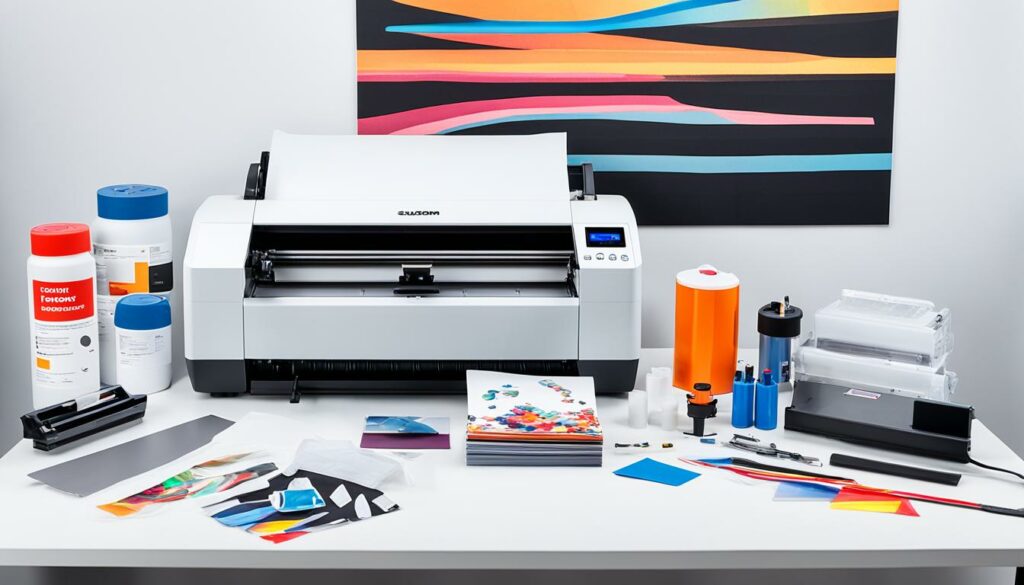
| Supplies for Sublimation Printing | Recommended Brands |
|---|---|
| Sublimation Paper | Brand A |
| Sublimation Printer | Brand B or Brand C |
| Heat Press Machine | Brand D or Brand E |
| Thermal Transfer Tape | Brand F |
| Scissors | Any reputable brand |
| Teflon Sheet | Any reputable brand |
How to Sublimate Merchandise?
Sublimating merchandise is a simple and effective process that allows you to create personalized and vibrant prints on various products. By following a few easy steps, you can achieve professional-looking results. Here’s a guide on how to sublimate merchandise using the sublimation printing process:
Step 1: Print the Design
Start by printing your desired design onto sublimation paper using a sublimation printer with dye sublimation ink. Ensure that the image is sized correctly and positioned according to your merchandise. Remember, the sublimation process requires a mirror image of the final design.
Step 2: Cut the Sublimation Paper
Once the design is printed, carefully cut around the edges of the image to remove any excess paper. This step helps ensure a clean and precise transfer onto the merchandise.
Step 3: Prepare the Heat Press
Set up your heat press machine according to the recommended temperature and time for the specific type of merchandise you are sublimating. Refer to the instructions provided by the manufacturer or consult online resources for proper heat press settings. It is essential to achieve the optimal temperature and time to ensure the ink transfer is successful.
Step 4: Secure the Sublimation Paper
Position the cut sublimation paper with the design facing down onto the merchandise. Use thermal transfer tape to secure the paper and prevent any movement during the pressing process. Pay attention to align the design properly, ensuring it covers the desired area of the merchandise.
Step 5: Press and Remove
Place the merchandise with the secured sublimation paper into the heat press, ensuring even pressure distribution. Close the heat press and allow the sublimation process to take place according to the recommended time. Once the time is complete, carefully open the heat press and remove the merchandise. Be cautious as the item will be hot.
For best results, promptly remove the sublimation paper, leaving behind the permanent and vibrant print on the merchandise. Allow the merchandise to cool before handling it or preparing it for further use.
It’s important to note that different types of merchandise may have specific temperature and time requirements. Consult the sublimation paper and merchandise manufacturers’ recommendations for optimal results.
Here’s a visual representation of the sublimation printing process:
| Steps | Sublimation Printing Process |
|---|---|
| Step 1 | Print the design on sublimation paper using a sublimation printer. |
| Step 2 | Cut the sublimation paper to remove excess edges. |
| Step 3 | Prepare the heat press with the recommended temperature and time. |
| Step 4 | Secure the sublimation paper on the merchandise with thermal transfer tape. |
| Step 5 | Press the merchandise in the heat press for the required time. |
| Step 6 | Remove the sublimation paper to reveal the permanent print on the merchandise. |
With these simple steps, you can transform blank merchandise into personalized and vibrant products using the sublimation printing process. Remember to always follow the recommended temperature and time settings for each type of merchandise to achieve optimal results.

Sublimation vs. Heat Transfer Paper: Which Is Better?
When it comes to printing methods, sublimation paper and heat transfer paper offer distinctive advantages. Sublimation paper utilizes dye sublimation ink that transforms into a gas when exposed to heat, resulting in vibrant and permanent prints that become part of the substrate. On the other hand, heat transfer paper relies on wax and pigment to transfer the design onto the substrate. The choice between the two methods depends on your preferences and desired outcomes.
If you value vibrant and long-lasting prints, sublimation paper is the way to go. The dye sublimation ink used in this method produces stunning and permanent results on a variety of materials. Its compatibility with polyester fabrics and sublimation blanks makes it ideal for customizing items like t-shirts, mugs, mouse pads, and keychains.
Heat transfer paper, on the other hand, is better suited for certain applications. It is commonly used for creating designs on fabrics with dark colors or for projects that require detailed, intricate designs. However, it should be noted that heat transfer paper can sometimes result in a slightly less vibrant print compared to sublimation paper.
Key Differences in Printing Methods
Here is a summary of the differences between sublimation paper and heat transfer paper:
| Printing Method | Ink Type | Print Quality | Material Compatibility |
|---|---|---|---|
| Sublimation Paper | Dye sublimation ink | Vibrant and permanent | Compatible with polyester fabrics and sublimation blanks |
| Heat Transfer Paper | Wax and pigment | Slightly less vibrant | Suitable for dark-colored fabrics and detailed designs |
It is worth mentioning that the choice between sublimation paper and heat transfer paper also depends on the ink compatibility of your printer. Sublimation ink is specifically designed for use with inkjet printers, while heat transfer paper can be used with a wider range of printer types.
Ultimately, the decision between sublimation paper and heat transfer paper is determined by your specific printing needs, material compatibility, and desired print quality. Assess your project requirements and consider the recommendations provided to make an informed choice that will yield exceptional results.
Which Printers Can You Use With Sublimation Paper?
When it comes to sublimation printing, specific printers are designed to provide the best results. However, you can also use a regular inkjet printer with dye sublimation ink to achieve similar outcomes. It’s crucial to ensure that the printer is compatible with sublimation printing before using it to avoid any issues.
Epson and SawGrass are two trusted brands that offer dedicated sublimation printers. These printers are specifically engineered to deliver outstanding print quality and efficiency for sublimation projects. They are designed to work seamlessly with sublimation paper, ensuring compatibility and optimal performance.
Laser printers, on the other hand, are generally not recommended for sublimation printing as they use a different printing technology that is not compatible with sublimation inks. Additionally, HP printers may not always be compatible with sublimation printing, so it’s essential to verify their compatibility before use.
Let’s explore some key considerations when choosing a printer for sublimation printing:
- Compatibility: Ensure that the printer is compatible with sublimation inks and sublimation paper for optimal results.
- Print Quality: Look for a printer that offers high-resolution printing capabilities to produce vibrant and sharp prints.
- Size and Format: Consider the size and format of the projects you plan to undertake. Choose a printer that can accommodate the desired size of the final prints.
- Budget: Evaluate your budget and compare the features and capabilities of different printers to find one that fits within your price range.
Remember, using a printer specifically designed for sublimation printing, such as those from Epson or SawGrass, ensures the best possible results. However, if you already have an inkjet printer, you can explore the option of using it with dye sublimation ink as a more budget-friendly alternative.
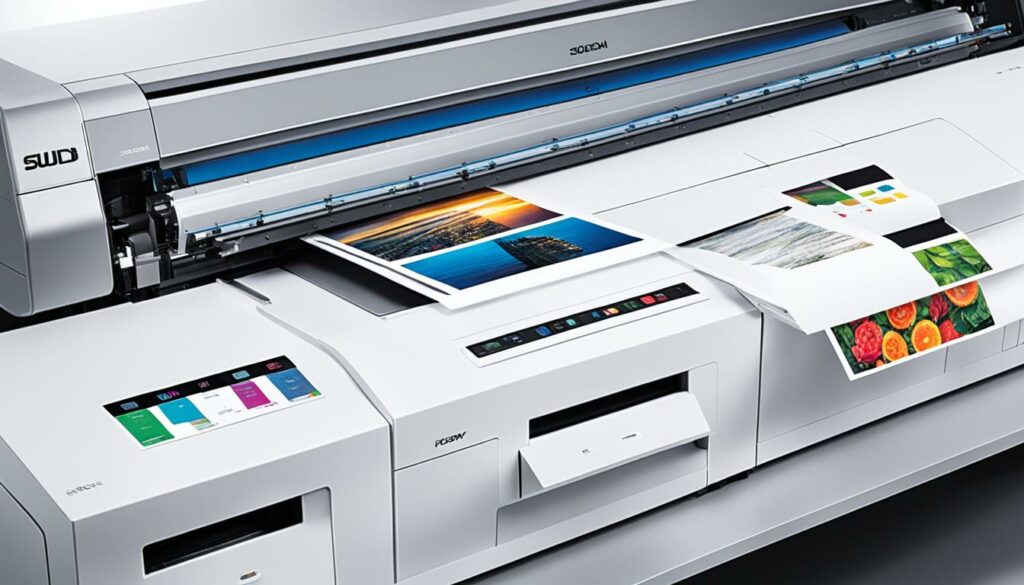
Having the right printer is crucial for successful sublimation printing, as it significantly impacts the quality and durability of your final prints. Take the time to research and choose a printer that meets your specific needs and ensures compatibility with sublimation paper and inks. With the right printer, you’ll be well-equipped to unleash your creativity and achieve stunning results in your sublimation projects.
Conclusion
Sublimation paper is a versatile tool that allows you to create vibrant and permanent prints on various substrates. Through this comprehensive sublimation printing guide, you have gained valuable insights on how to effectively use sublimation paper in your projects.
By following the step-by-step instructions and tips provided, you can achieve stunning results in your sublimation printing endeavors. Remember to choose high-quality supplies, such as sublimation ink and substrates, to ensure the best outcomes.
Experimenting with different settings and techniques will help you optimize sublimation paper usage. Whether you’re printing on polyester fabric or sublimation blanks, sublimation paper is your go-to solution for creating custom-printed merchandise.
With this knowledge at hand, you are well-equipped to embark on your sublimation printing journey. Happy printing!
Source Links
- https://www.allprintheads.com/blogs/news/how-to-use-sublimation-transfer-paper
- https://teckwrapcraft.com/blogs/tips/what-is-sublimation-paper-the-ultimate-guide
- https://www.craftexpress.com/blog/sublimation-9/mastering-sublimation-transfer-paper-213

Morgan Azhari, the owner of PrinterUpdate.net, is a dedicated expert in the field of printers, leveraging a wealth of experience and education to create a platform that passionately shares insights and solutions.
With a goal to enhance the printer user experience, my vision for the website is to provide valuable content, making a positive impact on individuals navigating the complexities of printers.
